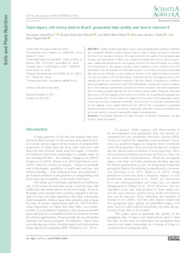Open legacy soil survey data in Brazil: geospatial data quality and how to improve it.
Open legacy soil survey data in Brazil: geospatial data quality and how to improve it.
Author(s): SAMUEL-ROSA, A.; DALMOLIN, R. S. D.; MOURA-BRUNO, J. M.; TEIXEIRA, W. G.; FILIPPINI ALBA, J. M.
Summary: Spatial soil data applications require sound geospatial data including coordinates and a coordinate reference system. However, when it comes to legacy soil data we frequently find them to be missing or incorrect. This paper assesses the quality of the geospatial data of legacy soil observations in Brazil, and evaluates geospatial data sources (survey reports, maps, spatial data infrastructures, web mapping services) and expert knowledge as a means to fix inconsistencies. The analyses included several consistency checks performed on 6,195 observations from the Brazilian Soil Information System. The positional accuracy of geospatial data sources was estimated so as to obtain an indication of the quality for fixing inconsistencies. The coordinates of 20 soil observations, estimated using the web mapping service, were validated with the true coordinates measured in the field. Overall, inconsistencies of different types and magnitudes were found in half of the observations, causing mild to severe misplacements. The involuntary substitution of symbols and numeric characters with similar appearance when recording geospatial data was the most common typing mistake. Among the geospatial data sources, the web mapping service was the most useful, due to operational advantages and lower positional error (~6 m). However, the quality of the description of the observation location controls the accuracy of estimated coordinates. Thus, the error of coordinates estimated using the web mapping service ranged between 30 and 1000 m. This is equivalent to coordinates measured from arc-seconds to arc-minutes, respectively. Under this scenario, the feedback from soil survey experts is crucial to improving the quality of geospatial data.
Publication year: 2020
Types of publication: Journal article
Unit: Embrapa Soils
Observation
Some of Embrapa's publications are published as ePub files. To read them, use or download one of the following free software options to your computer or mobile device. Android: Google Play Books; IOS: iBooks; Windows and Linux: Calibre.
Access other publications
Access the Agricultural Research Database (BDPA) to consult Embrapa's full library collection and records.
Visit Embrapa Bookstore to purchase books and other publications sold by Embrapa.

